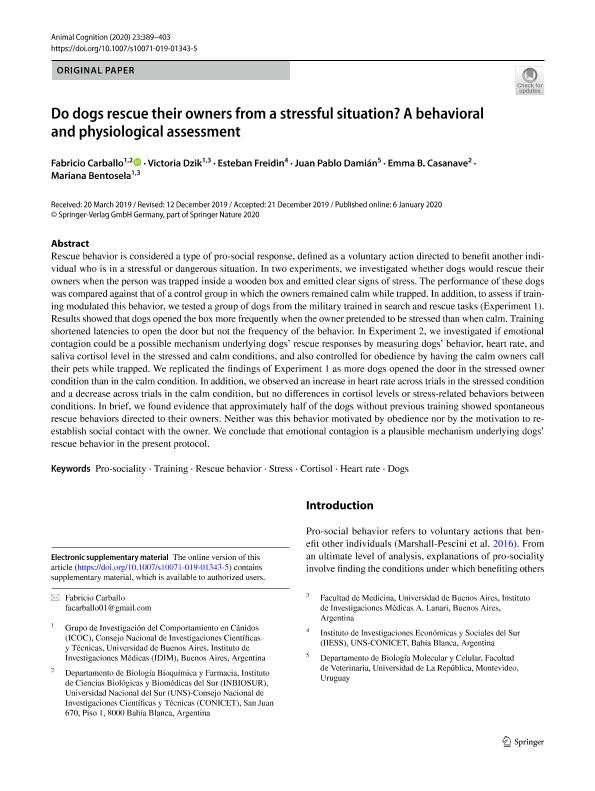Mostrar el registro sencillo del ítem
dc.contributor.author
Carballo Pozzo Ardizzi, Fabricio

dc.contributor.author
Dzik, Marina Victoria

dc.contributor.author
Freidin, Esteban

dc.contributor.author
Damián, Juan Pablo
dc.contributor.author
Casanave, Emma Beatriz

dc.contributor.author
Bentosela, Mariana

dc.date.available
2021-08-31T15:18:26Z
dc.date.issued
2020-01-06
dc.identifier.citation
Carballo Pozzo Ardizzi, Fabricio; Dzik, Marina Victoria; Freidin, Esteban; Damián, Juan Pablo; Casanave, Emma Beatriz; et al.; Do dogs rescue their owners from a stressful situation? A behavioral and physiological assessment; Springer Heidelberg; Animal Cognition; 23; 2; 6-1-2020; 389-403
dc.identifier.issn
1435-9448
dc.identifier.uri
http://hdl.handle.net/11336/139315
dc.description.abstract
Rescue behavior is considered a type of pro-social response, defined as a voluntary action directed to benefit another individual who is in a stressful or dangerous situation. In two experiments, we investigated whether dogs would rescue their owners when the person was trapped inside a wooden box and emitted clear signs of stress. The performance of these dogs was compared against that of a control group in which the owners remained calm while trapped. In addition, to assess if training modulated this behavior, we tested a group of dogs from the military trained in search and rescue tasks (Experiment 1). Results showed that dogs opened the box more frequently when the owner pretended to be stressed than when calm. Training shortened latencies to open the door but not the frequency of the behavior. In Experiment 2, we investigated if emotional contagion could be a possible mechanism underlying dogs' rescue responses by measuring dogs’ behavior, heart rate, and saliva cortisol level in the stressed and calm conditions, and also controlled for obedience by having the calm owners call their pets while trapped. We replicated the findings of Experiment 1 as more dogs opened the door in the stressed owner condition than in the calm condition. In addition, we observed an increase in heart rate across trials in the stressed condition and a decrease across trials in the calm condition, but no differences in cortisol levels or stress-related behaviors between conditions. In brief, we found evidence that approximately half of the dogs without previous training showed spontaneous rescue behaviors directed to their owners. Neither was this behavior motivated by obedience nor by the motivation to re-establish social contact with the owner. We conclude that emotional contagion is a plausible mechanism underlying dogs’ rescue behavior in the present protocol.
dc.format
application/pdf
dc.language.iso
eng
dc.publisher
Springer Heidelberg

dc.rights
info:eu-repo/semantics/openAccess
dc.rights.uri
https://creativecommons.org/licenses/by-nc-sa/2.5/ar/
dc.subject
CORTISOL
dc.subject
DOGS
dc.subject
HEART RATE
dc.subject
PRO-SOCIALITY
dc.subject
RESCUE BEHAVIOR
dc.subject
STRESS
dc.subject
TRAINING
dc.subject.classification
Otras Psicología

dc.subject.classification
Psicología

dc.subject.classification
CIENCIAS SOCIALES

dc.title
Do dogs rescue their owners from a stressful situation? A behavioral and physiological assessment
dc.type
info:eu-repo/semantics/article
dc.type
info:ar-repo/semantics/artículo
dc.type
info:eu-repo/semantics/publishedVersion
dc.date.updated
2021-08-27T20:45:44Z
dc.journal.volume
23
dc.journal.number
2
dc.journal.pagination
389-403
dc.journal.pais
Alemania

dc.journal.ciudad
Heidelberg
dc.description.fil
Fil: Carballo Pozzo Ardizzi, Fabricio. Consejo Nacional de Investigaciones Científicas y Técnicas. Centro Científico Tecnológico Conicet - Bahía Blanca. Instituto de Ciencias Biológicas y Biomédicas del Sur. Universidad Nacional del Sur. Departamento de Biología, Bioquímica y Farmacia. Instituto de Ciencias Biológicas y Biomédicas del Sur; Argentina
dc.description.fil
Fil: Dzik, Marina Victoria. Consejo Nacional de Investigaciones Científicas y Técnicas. Oficina de Coordinación Administrativa Houssay. Instituto de Investigaciones Médicas. Universidad de Buenos Aires. Facultad de Medicina. Instituto de Investigaciones Médicas; Argentina
dc.description.fil
Fil: Freidin, Esteban. Consejo Nacional de Investigaciones Científicas y Técnicas. Centro Científico Tecnológico Conicet - Bahía Blanca. Instituto de Investigaciones Económicas y Sociales del Sur. Universidad Nacional del Sur. Departamento de Economía. Instituto de Investigaciones Económicas y Sociales del Sur; Argentina
dc.description.fil
Fil: Damián, Juan Pablo. Universidad de la República; Uruguay
dc.description.fil
Fil: Casanave, Emma Beatriz. Consejo Nacional de Investigaciones Científicas y Técnicas. Centro Científico Tecnológico Conicet - Bahía Blanca. Instituto de Ciencias Biológicas y Biomédicas del Sur. Universidad Nacional del Sur. Departamento de Biología, Bioquímica y Farmacia. Instituto de Ciencias Biológicas y Biomédicas del Sur; Argentina
dc.description.fil
Fil: Bentosela, Mariana. Consejo Nacional de Investigaciones Científicas y Técnicas. Oficina de Coordinación Administrativa Houssay. Instituto de Investigaciones Médicas. Universidad de Buenos Aires. Facultad de Medicina. Instituto de Investigaciones Médicas; Argentina
dc.journal.title
Animal Cognition

dc.relation.alternativeid
info:eu-repo/semantics/altIdentifier/doi/http://dx.doi.org/10.1007/s10071-019-01343-5
dc.relation.alternativeid
info:eu-repo/semantics/altIdentifier/url/https://link.springer.com/article/10.1007%2Fs10071-019-01343-5
Archivos asociados
